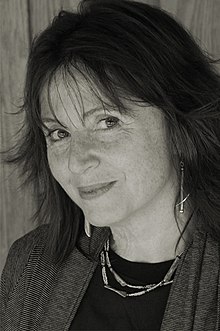Ruth Kedar
Ruth Kedar | |
|---|---|
 | |
| Born | January 27, 1955 Campinas, Brazil |
| Education | Technion, Stanford University |
| Known for | Graphic design, Art |
| Notable work | Google Logo |
Ruth Kedar (Hebrew: רות קדר; born 27 January 1955) is a Brazilian-born artist and designer, best known for designing the Google logo that was displayed from May 31, 1999 to September 1, 2015.[1][2][3] Larry Page and Sergey Brin were looking at designers to design their logo and website and Kedar was asked to present them with some preliminary design ideas. They liked her approach and design style, and she was hired to design both. The design was accepted due to its playful design, the customized Catull typeface and unique visual expression.[4]
Background
Born in Campinas, São Paulo, Brazil, she moved to Israel where she received a degree in Architecture from the Technion - Israel Institute of Technology. She moved to the US to attend the Stanford University master's Program in Design.
Career
Her master's thesis was on playing card design,[5] and she was commissioned by Adobe Systems to be one of the designers of the Adobe Deck, a promotional deck of playing cards produced in 1988. She went on to design the award-winning Analog Deck and Duolog Deck.[6][7][8]
She was a visiting art professor at the Stanford Art Department from 1988 to 1999.[9] It was while at Stanford that she was commissioned to design the Google logo.
Ruth practices the Martial Art of Aikido and holds the rank of Godan, 5th degree black belt. She teaches Aikido at Aikido West in Redwood City, CA.[10]
As an artist, Ruth is experimental by nature, and her work is drawn from personal stories about her life journey. Kedar often revisits and revises early artworks, injecting them with new life and new meaning. She calls this process "conversations with my younger self".[11]
Ruth’s artwork is infused with the vibrant colors and rhythms of the places she lived in São Paulo, Israel, United States, and the many places she has visited.
References
- ^ Fiegerman, Seth (2 September 2015). "Google's original logo designer reflects on a 'bittersweet' run". Mashable. Archived from the original on 11 October 2022. Retrieved 11 October 2022.
- ^ Paget, Ian (21 April 2019). "Designing the Google Logo - An interview with Ruth Kedar". Logo Geek. Retrieved 11 October 2022.
- ^ Zjawinski, Sonia (16 January 2000). "The Brains Behind Google's Primary Logo". Wired Magazine. ISSN 1059-1028. Archived from the original on 29 January 2022. Retrieved 11 October 2022.
- ^ Lenssen, Philipp (14 January 2008). "Ruth Kedar On Designing the Google Logo". Google Blogoscoped. Retrieved 28 October 2013.
- ^ Muller, Marion (Spring 1990). "From the Middle Ages to the Computer Age Playing Cards Have Not Changed Their Colors or Their Concepts" (PDF). Fast Fonts. Upper and Lower Case: Journal of Type and Graphic Design. International Typeface Corporation. Archived (PDF) from the original on 4 October 2022. Retrieved 11 October 2022.
- ^ "Analog & Duolog by Ruth Kedar". DXPO Playing Cards. Archived from the original on 8 October 2018. Retrieved 28 October 2013.
- ^ "Analog". Kedar Designs. Archived from the original on 4 October 2022. Retrieved 11 October 2022.
- ^ "Duolog". Kedar Designs. Archived from the original on 24 October 2020. Retrieved 11 October 2022.
- ^ "Professional Artists Bring Skills to Classroom". Stanford University News Service. Stanford. 1 March 1993. Archived from the original on 18 July 2022. Retrieved 2013-10-28.
- ^ "Ruth Kedar". Aikido West. Archived from the original on 11 October 2022. Retrieved 11 October 2022.
- ^ "About The Artist | Ruth Kedar". www.ruthkedar.com. Retrieved 2023-12-17.
